Binturong Profile
The binturong is an adorable mammal that lives in the tropical rainforests of Southeast Asia. Due to their loveable appearances and furry exterior, they are commonly called “bearcats”.
Binturongs are typically covered in shaggy black fur that is speckled with grey tips. Their whiskers are white, and they have long tufts of hair attached to their small rounded ears
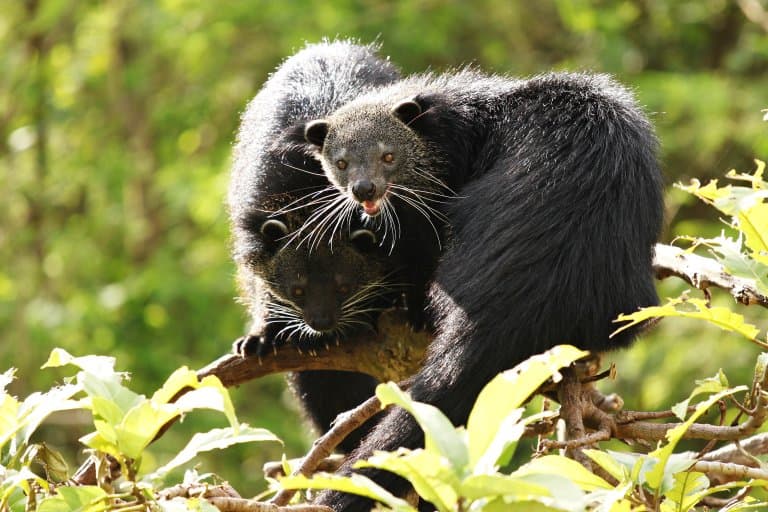
Binturong Facts Overview
| Habitat: | Tropical rainforests |
| Location: | South and Southeast Asia |
| Lifespan: | 18 years (in the wild) |
| Size: | 2.3 to 2.8 feet (body length) 2.1-2.3 feet (tail length) |
| Weight: | 24 to 70 pounds |
| Color: | Dark brown, grey, black |
| Diet: | Birds, fish, insects, leaves, fruit |
| Predators: | Tigers, snakes, humans |
| Top Speed: | 24 kph (15 mph) |
| No. of Species: |
1 |
| Conservation Status: |
Vulnerable |
Binturong live in countries stretching right across Asia, from India, through to Thailand, Cambodia, Indonesia and The Phillipines.
While they are deemed to be carnivores, binturongs eat mostly fruit and vegetables. Their faeces help to distribute seeds throughout the forests and replenish vegetation.
They love to lay in the sun and soak up the warm rays during the day. As nocturnal animals, binturongs are most active at night and use the cover of darkness to forage for food.
They are currently classified by the IUCN as a vulnerable species.
Unfortunately, their numbers have been decreasing for decades (beginning in the 1980s). Human practices, such as palm oil plantations, deforestation, and hunting – have had a significant impact on binturong food sources and habitats.
Interesting Binturong Facts
1. They smell like buttered popcorn
Binturongs produce secretions from glands located at the base of their tail.
These secretions are believed to function as carriers for pheromones used to demark territories and signal to other binturongs.
To humans, these secretions give off a scent reminiscent of buttered popcorn. 1
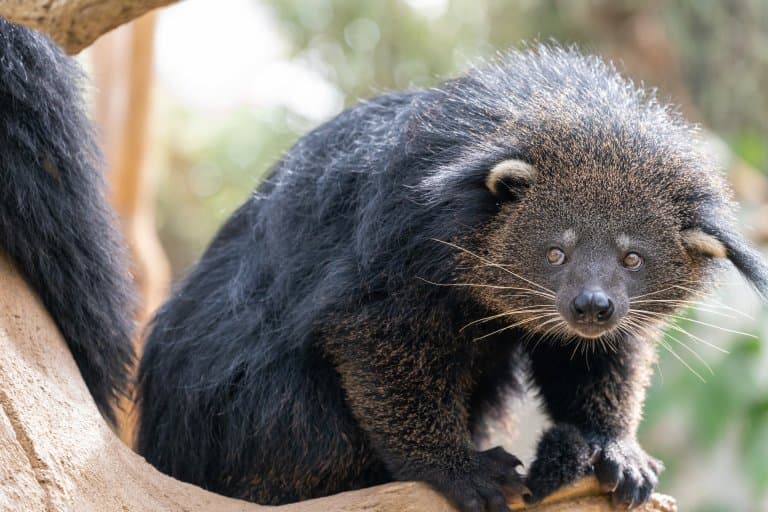
2. Their long tails can act like an extra arm
A binturong’s tail can measure almost the same length as its body. Like an elephant’s trunk, it is prehensile, meaning it can grasp onto items and maneuver them.
At night, when a binturong is sleeping high up in the trees, they will hold onto a nearby branch with their tails to prevent themselves from falling.
3. Their tails have a special patch of skin that help them grip onto objects
At the tip of their prehensile tails, there is a special area that feels like leather. This rough spot allows the animals to cling onto objects more strongly.

4. Their extremely flexible ankles make them expert climbers
On flat ground, binturongs are slow and clumsy. They waddle with their bodies low to the ground.
They are much more agile up in the trees. Their ankles can rotate a full 180 degrees, allowing them to clasp onto branches and climb down tree trunks headfirst. 2
5. Some people keep them as pets
In parts of Malaysia, binturongs are kept as pets.
Some are also sold into the meat and fur trades, although this has become increasingly discouraged as binturong populations are on the decline.
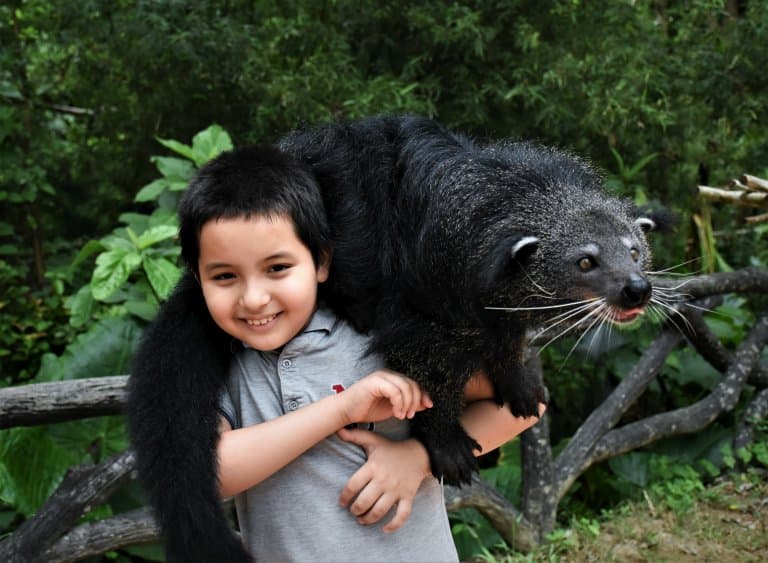
6. Despite being called ‘bearcats’, they are not related to bears or cats.
They are, in fact, more closely related to members of the Viverridae family, which include civets and genets.
7. In the wild, they are solitary animals
Binturongs tend to keep to themselves and only come together to mate during certain times of the year.
8. Female binturongs use delayed implantation to increase their chances of successfully bearing young
Delayed implantation is a reproductive strategy where animals delay the implantation of a fertilized egg until environmental conditions are more ideal.
Female binturongs can wait for days, weeks, or even months before becoming pregnant.
9. They cannot hop from tree to tree
They are good climbers, but even with a prehensile tail, binturongs are incapable of leaping between trees. To traverse between trees, they must descend to the ground and traverse that way.
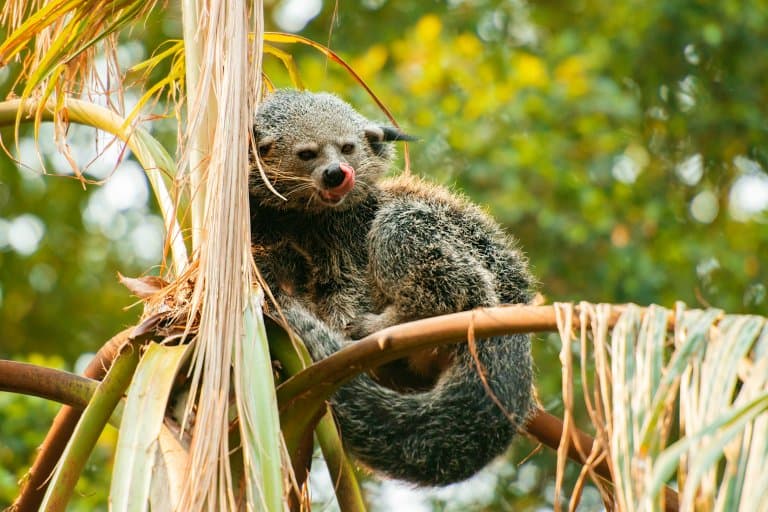
10. When encountered in the wild, they can be quite aggressive
Researchers who trap and study binturongs have often commented on the ferocity of binturongs.
They have even been found to chase humans when released back into the wild! 3
11. Baby binturongs are called ‘binlets’
Mothers usually give birth to one or two binlets. At birth, their eyes are still closed, and they will hold onto their mothers for security.
12. They do not fear water and are quite capable swimmers
Unlike cats, binturongs can dive and swim in shallow waters. They eat fish and other small mammals.
13. Their digestive systems help keep forests healthy and thriving
In addition to spreading seeds across the forest floor, the digestive systems of binturongs give seeds a better chance of growing once released.
Their stomachs contain enzymes that break down the tough outer shells of seeds, prepping them for germination. 4
14. Females are larger than males
Female binturongs are, on average, 20% larger than males. They will care for their young until binlets have acquired hunting skills and can fend for themselves. 5
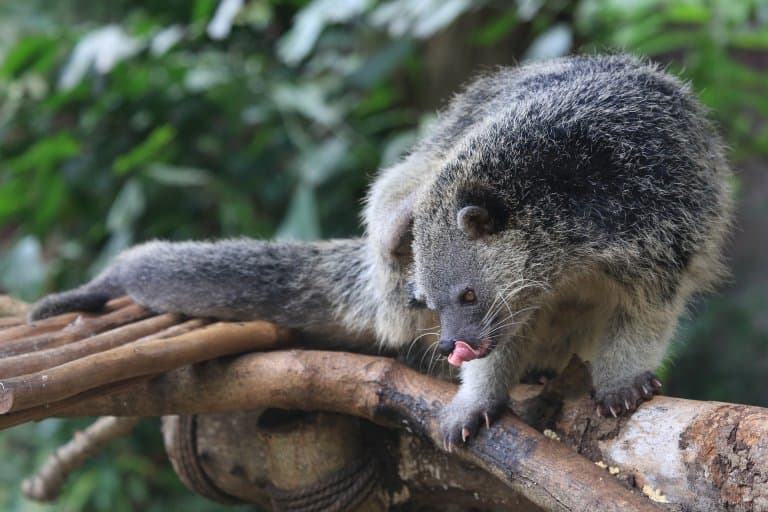
15. When communicating with each other, binturongs can be quite vocal
Binturongs have been observed hissing, growling, wailing, and grunting to potential mates or oncoming threats.
16. Nobody quite knows what ‘binturong’ means
The meaning of the name ‘binturong’ is unknown. It was derived from an ancient language that is now extinct!
Binturong Fact-File Summary
Scientific Classification
| Kingdom: | Animalia |
| Phylum: | Chordata |
| Class: | Mammalia |
| Order: | Carnivora |
| Suborder: | Feliformia |
| Family: | Viverridae |
| Subfamily: | Paradoxurinae |
| Genus: | Arctictis |
| Species Name: |
Arctictis Binturong |
Fact Sources & References
- “Binturong”. National Geographic.
- “Binturong”. San Diego Zoo.
- Nairn, Carly. “What is a binturong?” Mongabay News.
- Lambert, F. (1990), “Some notes on fig-eating by arboreal mammals in Malaysia“, Primates 31 (3): 453–458.
- “The tree-dwelling mammal with a surprisingly familiar scent”. World Wildlife Fund.
